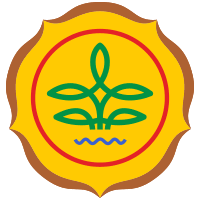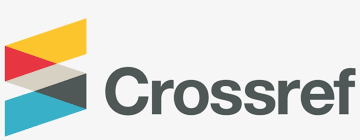Antagonist Test of Trichoderma sp and Gliocladium sp Againts Fungal Pathogens That Cause Diseases on Tomato Plant
Abstract
Tomatoes (Solanum lycopersicum) are one of the widely cultivated crops consumed by people worldwide, including Indonesia. Tomato farming often faces various challenges that result in reduced tomato productivity. One of the challenges is the presence of diseases that affect tomatoes, leading to crop failure for farmers. Some important diseases that commonly affect tomato plants include Fusarium wilt and anthracnose. Most farmer use chemical fungicides to control the diseases. These methods have greater negative impacts on both plants and the surrounding environment. One alternative control technique that can be used is the use of biological agents with antagonistic properties, such as Trichoderma sp. and Gliocladium sp. This research aims to assess antagonistic abilities of endophytic fungi Trichoderma sp. and Gliocladium sp. againts the pathogens responsible for suppresing the growth of these disease-causing phatogens in tomato plants. in the Laboratory of Plant Pest and Disease Science, OECF Building, Faculty of Agriculture, Universitas Mulawarman. The experiment was designed using a completely randomized single-factor design with four treatments and five replications. The data obtained were analyzed using Analysis of Variance and the least significant difference test at a 5% significance level. The research results indicate that the antagonistic tests of Trichoderma sp. and Gliocladium sp. in vitro significantly differ againts the pathogenic fungi Fusarium sp. and Colletotrichum sp. Furthermore, it was found that the antagonistic fungus Gliocladium sp. is the best fungus capable of suppressing the growth of important pathogenic fungi in tomato plants.
Keyword: Gliocladium sp., Trichoderma sp., Fusarium sp., Colletotrichum sp. and Tomato (Solanum lycopersicum)
Keywords
Full Text:
PDFReferences
Barnett HL, dan Hunter BB. 1998. Ilustrated Genera of Imperfect Fungi, 4thedition. APS Press. New Zealand
Chaverri P, and Samuels GJ. 2013. Hypocrea/Trichoderma (Ascomycota, Hypocreales, Hypocreaceae): species with green ascospores. Studies in Mycology 74(1): 1-66.
Heryanto. 2019. Study of Control of Fusarium Disease with Trichoderma on Tomato Plants. J. Trit 10(1)
Inaya N, Meriem S., dan Masiany M. 2022. Identifikasi Morfologi Penyakit Tanaman Cabai (Capsicum sp.) yang Disebabkan Oleh Patogen dan Serangan Hama. Filogeni J. Mhs. Biologi 2(1): 8-14.
Olebila DY, Rosmana A., dan Tresnaputra US. 2020. Trichoderma Asal Akar Kopi dari Alor: Karakterisasi Morfologi dan Keefektifannya Menghambat Colletotrichum Penyebab Penyakit Antraknosa Secara InVitro.
J. Fitopatol. Indones 16(2): 61-68.
Rahma YA, dan Karimah I. 2021. Eksplorasi dan Identifikasi Agen Hayati Gliocladium sp. dalam Menghambat Pertumbuhan Cendawan Patogen Colletotrichum sp. Pros. Semnas Bio 1: 432-440.
Saputa R, Puspita F, Hamzah A, Irfandri dan Suryani E. 2022. Morphological Characterization of Trichoderma sp. Isolated from the Palm Oil Rhizosphere in Peat Soils and its Potential as a Biological Contol for Ganoderma sp. in vitro. Jurnal Ilmiah Pertaniam 19(2): 56-68.
Sholihah RI, Sritamin M, dan Wijaya, IN. 2019. Identifikasi Jamur Fusarium solani yang Berasosiasi Dengan Penyakit Busuk Batang Pada Tanaman Buah Naga (Hylocereus sp.) di Kecamatan Bangorejo, Kabupaten Banyuwangi. E-Jurnal Agroekoteknologi Trop 8(1): 91-102.
Sopialena S, Suyadi S, Sofian S, Tantiani D., dan Fauzi AN. 2020. Efektifitas Cendawan Endofit sebagai Pengendali Blast Pada Tanaman Padi (Oryza sativa). Agrifor 19(2): 355. https://doi.org/10.31293/af.v19i2.4813
Sopialena S, Subiono T, Rosyidin AU., dan Tantiani D. 2022. Control of Antracnose Disease in Tomato (Solanum Lycopersicum) Using Endophytic Fungi. KnE Life Sciences. https://doi.org/10.18502/kls.v7i3.11147
Sopialena, Suyadi, Sofian, Tantiani D., dan Nur FA. 2020. Efektivitas Cendawan Endofit Sebagai Pengendali Penyakit BlastPada Tanaman Padi (Oryza sativa). Jurnal AGRIFOR, 19(2), 355–366. https://doi.org/10.31293/af.v19i2.4813
Sopialena, dan Wati M. 2018. Uji Potensi Penggunaan Jamur Trichoderma harzianum Rifai dan Gliocladium virens Arx untuk Mengendalikan Penyakit Bercak Daun pada Cabai Rawit (Capsicum frutescens L.). Jurnal Agroekoekoteknologi Tropika Lembab, 1(1), 61–66. https://doi.org/10.35941/jatl.1.1.2018.1511.61-66
Watanabe T. 2002. Pictorial Atlas of Soil and Seed Fungi: Morphologies of Cultured Fungi and Key to Species, Third Edition. CRC Press. Taylor and Francis Group. United States.
Wiyana S, Rahmawati R, dan Mukarlina M. 2022. Karakteristik Morfologis Aspergillus dan Colletotrichum dari Daun Jeruk Siam (Citrus nobilis var. microcarpa) Bergejala Sakit di Perkebunan Jeruk Kota Singkawang. J. Mikol Indones 1(1):28-37.
DOI: http://dx.doi.org/10.30872/jatl.7.1.2024.15636.78-84
Refbacks
- There are currently no refbacks.
Copyright (c) 2024 Jurnal Agroekoteknologi Tropika Lembab







4.jpg)
.jpg)











